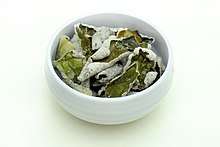Saccharina japonica
| Saccharina japonica | |
|---|---|
 | |
| Scientific classification | |
| (unranked): | SAR |
| Superphylum: | Heterokonta |
| Class: | Phaeophyceae |
| Order: | Laminariales |
| Family: | Laminariaceae |
| Genus: | Saccharina |
| Species: | S. japonica |
| Binomial name | |
| Saccharina japonica (J.E. Areschoug) C.E. Lane, C. Mayes, Druehl & G.W. Saunders | |
| Synonyms | |
|
Laminaria japonica J.E. Areschoug | |
Saccharina japonica is a marine species of Phaeophyceae (brown algae), a type of kelp or seaweed, that is extensively cultivated on ropes in between the seas of Japan and Korea.[1] It is widely eaten in East Asia.[2] A commercially important species, S. japonica is known as called ma-konbu (真昆布) in Japanese, dasima (다시마) in Korean and hǎidài (海带) in Chinese.[2] Large harvests are produced by rope cultivation, a simple method of growing seaweeds by attaching them to floating ropes in the ocean.[1][3]
The species has been cultivated in China, Japan, Russia, France and Korea.[4] It is one of the two most consumed species of kelp in China and Japan.[1] The harvest is also used for the production of alginates, with China producing up to ten thousand tons of the product each year.[5]
Consuming excessive S. japonica suppresses thyroid function.[6]
The species was transferred to Saccharina in 2006.[7] Three synonyms for this species name are Laminaria japonica (J. E. Areschoug 1851), its variety Laminaria japonica var. ochotensis (Miyabe Okamura 1936) and Laminaria ochotensis (Miyabe 1902).[4]
With the development of cultivation technology, over 90% of Japanese kombu is cultivated, mostly in Hokkaidō, but as far as south of the Seto Inland Sea.
Culinary use
Korea
In Korean cuisine, dasima is used to make broth, deep-fried into bugak or twigak (coated and uncoated fries), pickled in soy sauce as jangajji, and eaten raw as a sea vegetable for ssam (wraps).
It is also used to make dasima-cha (kelp tea).
Cheonsa-chae (kelp noodles) is made from the alginic acid from dasima.
 Raw dasima served as a ssam vegetable, with dipping sauces
Raw dasima served as a ssam vegetable, with dipping sauces Dried dasima for broth
Dried dasima for broth Dasima-bugak (deep-fried kelp snack)
Dasima-bugak (deep-fried kelp snack) Cheonsa-chae (kelp noodles)
Cheonsa-chae (kelp noodles)
See also
References
Citations
- 1 2 3 M. D. Guiry. "Kelps: Laminaria and Saccharina". www.seaweed.ie.
- 1 2 Abbott, Isabella A (1989). "Food and food products from seaweeds". In Lembi, Carole A.; Waaland, J. Robert. Algae and human affairs. Cambridge University Press, Phycological Society of America. p. 141. ISBN 978-0-521-32115-0.
- ↑ Laminaria seafarming in China FAO
- 1 2 Guiry, M.D.; Guiry, G.M. (2008). "'Saccharina japonica'". AlgaeBase. World-wide electronic publication, National University of Ireland, Galway.
- ↑ M. D. Guiry. "Alginates". www.seaweed.ie.
- ↑ Miyai, Kiyoshi; Tokushige, Tomoyasu; Kondo, Masahiko (2008-12-01). "Suppression of thyroid function during ingestion of seaweed "Kombu" (Laminaria japonoca) in normal Japanese adults". Endocrine Journal. 55 (6): 1103–1108. doi:10.1507/endocrj.k08e-125. ISSN 1348-4540. PMID 18689954.
- ↑ Lane, C.E., Mayes, C., Druehl, L.D. & Saunders, G.W. (2006). A multi-gene molecular investigation of the kelp (Laminariales, Phaeophyceae) supports substantial taxonomic re-organization. Journal of Phycology 42: 493-512.
Sources
- Davidson, Alan. Oxford Companion to Food (1999), "Kombu", p. 435. ISBN 0-19-211579-0
- Culture of Kelp (Laminaria japonica) in China
- Hosking, Richard (1996). A dictionary of Japanese food: ingredients & culture. Tuttle Publishing. pp. 206–208. ISBN 978-0-8048-2042-4.
External links
| Wikimedia Commons has media related to Kombu. |